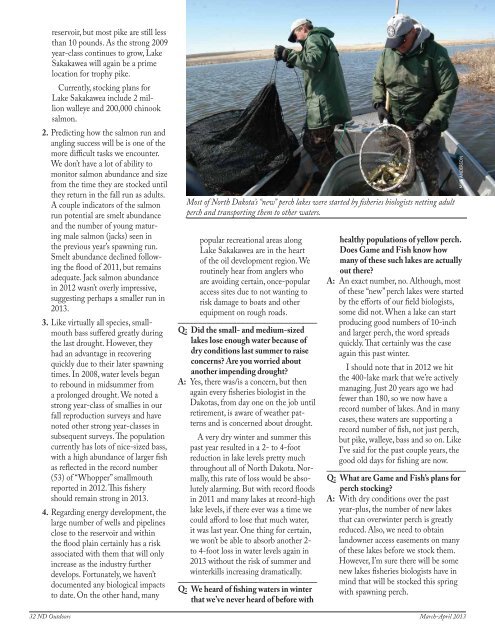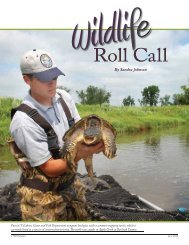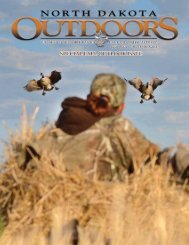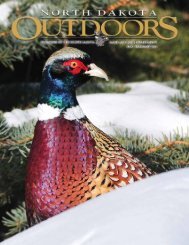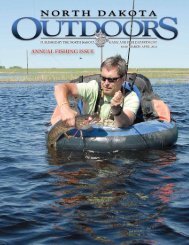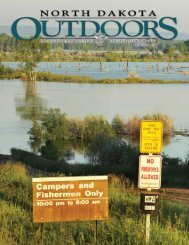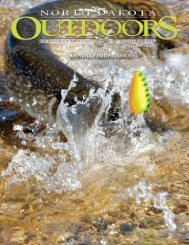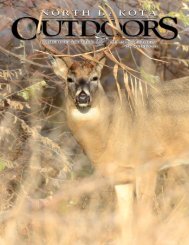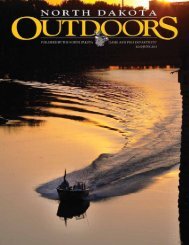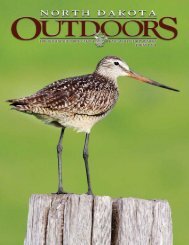March_April 2013.pdf - North Dakota Game and Fish
March_April 2013.pdf - North Dakota Game and Fish
March_April 2013.pdf - North Dakota Game and Fish
- No tags were found...
You also want an ePaper? Increase the reach of your titles
YUMPU automatically turns print PDFs into web optimized ePapers that Google loves.
eservoir, but most pike are still lessthan 10 pounds. As the strong 2009year-class continues to grow, LakeSakakawea will again be a primelocation for trophy pike.Currently, stocking plans forLake Sakakawea include 2 millionwalleye <strong>and</strong> 200,000 chinooksalmon.2. Predicting how the salmon run <strong>and</strong>angling success will be is one of themore difficult tasks we encounter.We don’t have a lot of ability tomonitor salmon abundance <strong>and</strong> sizefrom the time they are stocked untilthey return in the fall run as adults.A couple indicators of the salmonrun potential are smelt abundance<strong>and</strong> the number of young maturingmale salmon (jacks) seen inthe previous year’s spawning run.Smelt abundance declined followingthe flood of 2011, but remainsadequate. Jack salmon abundancein 2012 wasn’t overly impressive,suggesting perhaps a smaller run in2013.3. Like virtually all species, smallmouthbass suffered greatly duringthe last drought. However, theyhad an advantage in recoveringquickly due to their later spawningtimes. In 2008, water levels beganto rebound in midsummer froma prolonged drought. We noted astrong year-class of smallies in ourfall reproduction surveys <strong>and</strong> havenoted other strong year-classes insubsequent surveys. The populationcurrently has lots of nice-sized bass,with a high abundance of larger fishas reflected in the record number(53) of “Whopper” smallmouthreported in 2012. This fisheryshould remain strong in 2013.4. Regarding energy development, thelarge number of wells <strong>and</strong> pipelinesclose to the reservoir <strong>and</strong> withinthe flood plain certainly has a riskassociated with them that will onlyincrease as the industry furtherdevelops. Fortunately, we haven’tdocumented any biological impactsto date. On the other h<strong>and</strong>, manyMost of <strong>North</strong> <strong>Dakota</strong>’s “new” perch lakes were started by fisheries biologists netting adultperch <strong>and</strong> transporting them to other waters.popular recreational areas alongLake Sakakawea are in the heartof the oil development region. Weroutinely hear from anglers whoare avoiding certain, once-popularaccess sites due to not wanting torisk damage to boats <strong>and</strong> otherequipment on rough roads.Q: Did the small- <strong>and</strong> medium-sizedlakes lose enough water because ofdry conditions last summer to raiseconcerns? Are you worried aboutanother impending drought?A: Yes, there was/is a concern, but thenagain every fisheries biologist in the<strong>Dakota</strong>s, from day one on the job untilretirement, is aware of weather patterns<strong>and</strong> is concerned about drought.A very dry winter <strong>and</strong> summer thispast year resulted in a 2- to 4-footreduction in lake levels pretty muchthroughout all of <strong>North</strong> <strong>Dakota</strong>. Normally,this rate of loss would be absolutelyalarming. But with record floodsin 2011 <strong>and</strong> many lakes at record-highlake levels, if there ever was a time wecould afford to lose that much water,it was last year. One thing for certain,we won’t be able to absorb another 2-to 4-foot loss in water levels again in2013 without the risk of summer <strong>and</strong>winterkills increasing dramatically.Q: We heard of fishing waters in winterthat we’ve never heard of before withhealthy populations of yellow perch.Does <strong>Game</strong> <strong>and</strong> <strong>Fish</strong> know howmany of these such lakes are actuallyout there?A: An exact number, no. Although, mostof these “new” perch lakes were startedby the efforts of our field biologists,some did not. When a lake can startproducing good numbers of 10-inch<strong>and</strong> larger perch, the word spreadsquickly. That certainly was the caseagain this past winter.I should note that in 2012 we hitthe 400-lake mark that we’re activelymanaging. Just 20 years ago we hadfewer than 180, so we now have arecord number of lakes. And in manycases, these waters are supporting arecord number of fish, not just perch,but pike, walleye, bass <strong>and</strong> so on. LikeI’ve said for the past couple years, thegood old days for fishing are now.Q: What are <strong>Game</strong> <strong>and</strong> <strong>Fish</strong>’s plans forperch stocking?A: With dry conditions over the pastyear-plus, the number of new lakesthat can overwinter perch is greatlyreduced. Also, we need to obtainl<strong>and</strong>owner access easements on manyof these lakes before we stock them.However, I’m sure there will be somenew lakes fisheries biologists have inmind that will be stocked this springwith spawning perch.MIKE ANDERSON32 ND Outdoors <strong>March</strong>-<strong>April</strong> 2013


